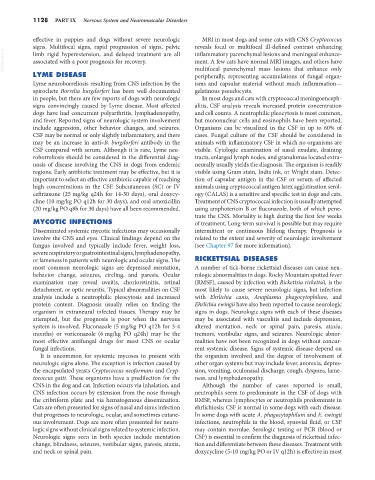Page 1156 - Small Animal Internal Medicine, 6th Edition
P. 1156
1128 PART IX Nervous System and Neuromuscular Disorders
effective in puppies and dogs without severe neurologic MRI in most dogs and some cats with CNS Cryptococcus
signs. Multifocal signs, rapid progression of signs, pelvic reveals focal or multifocal ill-defined contrast enhancing
VetBooks.ir limb rigid hyperextension, and delayed treatment are all inflammatory parenchymal lesions and meningeal enhance-
ment. A few cats have normal MRI images, and others have
associated with a poor prognosis for recovery.
LYME DISEASE multifocal parenchymal mass lesions that enhance only
peripherally, representing accumulations of fungal organ-
Lyme neuroborreliosis resulting from CNS infection by the isms and capsular material without much inflammation—
spirochete Borrelia burgdorferi has been well documented gelatinous pseudocysts.
in people, but there are few reports of dogs with neurologic In most dogs and cats with cryptococcal meningoenceph-
signs convincingly caused by Lyme disease. Most affected alitis, CSF analysis reveals increased protein concentration
dogs have had concurrent polyarthritis, lymphadenopathy, and cell counts. A neutrophilic pleocytosis is most common,
and fever. Reported signs of neurologic system involvement but mononuclear cells and eosinophils have been reported.
include aggression, other behavior changes, and seizures. Organisms can be visualized in the CSF in up to 60% of
CSF may be normal or only slightly inflammatory, and there cases. Fungal culture of the CSF should be considered in
may be an increase in anti–B. burgdorferi antibody in the animals with inflammatory CSF in which no organisms are
CSF compared with serum. Although it is rare, Lyme neu- visible. Cytologic examination of nasal exudate, draining
roborreliosis should be considered in the differential diag- tracts, enlarged lymph nodes, and granulomas located extra-
nosis of disease involving the CNS in dogs from endemic neurally usually yields the diagnosis. The organism is readily
regions. Early antibiotic treatment may be effective, but it is visible using Gram stain, India ink, or Wright stain. Detec-
important to select an effective antibiotic capable of reaching tion of capsular antigen in the CSF or serum of affected
high concentrations in the CSF. Subcutaneous (SC) or IV animals using cryptococcal antigen latex agglutination serol-
ceftriaxone (25 mg/kg q24h for 14-30 days), oral doxycy- ogy (CALAS) is a sensitive and specific test in dogs and cats.
cline (10 mg/kg PO q12h for 30 days), and oral amoxicillin Treatment of CNS cryptococcal infection is usually attempted
(20 mg/kg PO q8h for 30 days) have all been recommended. using amphotericin B or fluconazole, both of which pene-
trate the CNS. Mortality is high during the first few weeks
MYCOTIC INFECTIONS of treatment. Long-term survival is possible but may require
Disseminated systemic mycotic infections may occasionally intermittent or continuous lifelong therapy. Prognosis is
involve the CNS and eyes. Clinical findings depend on the related to the extent and severity of neurologic involvement
fungus involved and typically include fever, weight loss, (see Chapter 97 for more information).
severe respiratory or gastrointestinal signs, lymphadenopathy,
or lameness in patients with neurologic and ocular signs. The RICKETTSIAL DISEASES
most common neurologic signs are depressed mentation, A number of tick-borne rickettsial diseases can cause neu-
behavior change, seizures, circling, and paresis. Ocular rologic abnormalities in dogs. Rocky Mountain spotted fever
examination may reveal uveitis, chorioretinitis, retinal (RMSF), caused by infection with Rickettsia rickettsii, is the
detachment, or optic neuritis. Typical abnormalities on CSF most likely to cause severe neurologic signs, but infection
analysis include a neutrophilic pleocytosis and increased with Ehrlichia canis, Anaplasma phagocytophilum, and
protein content. Diagnosis usually relies on finding the Ehrlichia ewingii have also been reported to cause neurologic
organism in extraneural infected tissues. Therapy may be signs in dogs. Neurologic signs with each of these diseases
attempted, but the prognosis is poor when the nervous may be associated with vasculitis and include depression,
system is involved. Fluconazole (5 mg/kg PO q12h for 3-4 altered mentation, neck or spinal pain, paresis, ataxia,
months) or voriconazole (6 mg/kg PO q24h) may be the tremors, vestibular signs, and seizures. Neurologic abnor-
most effective antifungal drugs for most CNS or ocular malities have not been recognized in dogs without concur-
fungal infections. rent systemic disease. Signs of systemic disease depend on
It is uncommon for systemic mycoses to present with the organism involved and the degree of involvement of
neurologic signs alone. The exception is infection caused by other organ systems but may include fever, anorexia, depres-
the encapsulated yeasts Cryptococcus neoformans and Cryp- sion, vomiting, oculonasal discharge, cough, dyspnea, lame-
tococcus gatti. These organisms have a predilection for the ness, and lymphadenopathy.
CNS in the dog and cat. Infection occurs via inhalation, and Although the number of cases reported is small,
CNS infection occurs by extension from the nose through neutrophils seem to predominate in the CSF of dogs with
the cribriform plate and via hematogenous dissemination. RMSF, whereas lymphocytes or neutrophils predominate in
Cats are often presented for signs of nasal and sinus infection ehrlichiosis; CSF is normal in some dogs with each disease.
that progresses to neurologic, ocular, and sometimes cutane- In some dogs with acute A. phagocytophilum and E. ewingii
ous involvement. Dogs are more often presented for neuro- infections, neutrophils in the blood, synovial fluid, or CSF
logic signs without clinical signs related to systemic infection. may contain morulae. Serologic testing or PCR (blood or
Neurologic signs seen in both species include mentation CSF) is essential to confirm the diagnosis of rickettsial infec-
change, blindness, seizures, vestibular signs, paresis, ataxia, tion and differentiate between these diseases. Treatment with
and neck or spinal pain. doxycycline (5-10 mg/kg PO or IV q12h) is effective in most

